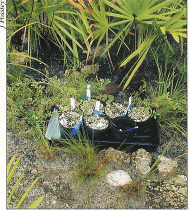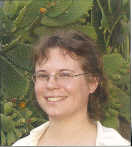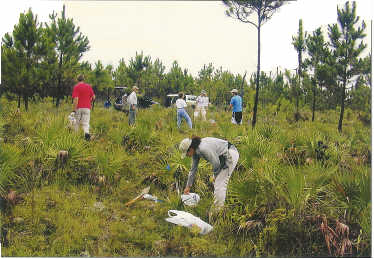A New Location for an Endangered Species: Tephrosia angustissima var. corallicola
Kristie Wendelberger, Field Botanist
 |
| Tephrosia ready and waiting to be planted |
 |
| Kristie Wendelberger |
The South Florida conservation team is proud to announce another 200 endangered plants have been relocated and are flourishing in a South Florida pine rockland. Tephrosia angustissima var. corallicola, commonly known as the hoary pea, previously had only one confirmed location in the world, but now it has two. This state-listed endangered species had the misfortune of finding itself in an agricultural area, where mowing and other agricultural practices slowed down its reproduction and hindered it from reaching new locations in the fragmented habitat.
This situation greatly concerned the Garden's conservation team, so we decided to take action. Starting in the winter of 2002, we began taking cuttings from the wild population to create a duplicate population that would be planted in a pine rockland fragment a few blocks away. Over the winter and spring months, Assistant Conservation Horticulturist Karen Griffin propagated and grew more than 1,000 cuttings at the Garden's nursery in preparation for June's out-planting. Of those cuttings, 150 made it first through the rigorous propagation process and then through the grueling selection process during which we chose the very best and healthiest plants for our experiment. The word "experiment" is not a mistake. With the only known wild population of Tephrosia growing in an area disturbed by rock plows and agriculture, the microhabitat this endangered plant prefers is unknown. Experimentation is necessary to determine the best place to plant the hoary pea. We do know it thrives in pine rockland soils, so we started by selecting a nearby pine rockland as the location for our experiment.
Within the selected rockland, we chose three sites to study: one between the edge of the rockland and a road; the second within the rockland associated with saw palmetto (Serenoa repens); and the third in an area under the canopy of slash pine (Pinus elliottii var. densa), which provided more shade than the other two locations. The experiment was designed to help us determine the preferred microhabitat of this species, thus increasing the possibility of success in future outplantings.
 |
| Volunteers water the newly planted Tephrosia one by one. |
In addition to the microhabitat study, a second experiment was set up by Dr. Jack B. Fisher, Senior Research Scientist, using 50 Tephrosia that he grew from seed. This experiment will determine the best way to propagate the sprawling, sun-loving pea and ensure that each specimen has the best chance of survival from seedling to mature plant. Tephrosia naturally lives in association with tiny soil fungi called mychorrhizae. These fungi help the plant to uptake water and nutrients in a more efficient manner while the plants gives the fungus carbon in return. Three propagation methods were tested by Dr. Fisher to determine which resulted in the best outplanting survival:
- grown with only mychorrhizae and no fertilizer,
- grown with mychorrhizae and fertilizer, or
- grown with only fertilizer and no mychorrhizae.
The outplanting itself took 22 people: 13 great volunteers; Arlene Ferris, Director of Volunteer Services; one horticultural staff member and seven conservation staff members. We spent one full morning planting and watering these little beauties. With so many helping hands, the work went faster than expected and was a great success. However, the planting was just the beginning. Since then, I have wrangled various co-workers into the tedious job of watering the Tephrosia by hand every three days until it rains or they are established. So far, the plants are doing well with little dieoff. It is good to know that all of our hard work has created a new, permanent location for the feisty pea.
Garden Views Autumn 2003